CHAPTER 18
Organizing with Outlook
Navigate in Outlook
Outlook functions as a personal organizer, with Mail, Calendar, People, Tasks, and Notes components. You switch between these components using the Navigation bar.
The Outlook Mail component appears by default when you open Outlook, and it enables you to send and receive e-mail messages. The Outlook Calendar component enables you to keep track of appointments. The Outlook People component enables you to maintain a database of your contacts and include those contacts in e-mail messages you send and appointments you schedule. The Outlook Tasks component enables you to keep a to-do list.
Navigate in Outlook

![]() Start Outlook.
Start Outlook.
Note: When Outlook opens, the Mail component (![]() ) appears by default. You can read more about using the Mail component in Chapter 19.
) appears by default. You can read more about using the Mail component in Chapter 19.
![]() Click Calendar (
Click Calendar (![]() ) in the Navigation bar.
) in the Navigation bar.
Note: As you hover the mouse (![]() ) over Calendar (
) over Calendar (![]() ), Outlook displays a preview of upcoming appointments.
), Outlook displays a preview of upcoming appointments.

Outlook displays the Month view of the Calendar component.
![]() Today’s date appears selected in the main calendar and in the navigational calendars.
Today’s date appears selected in the main calendar and in the navigational calendars.
![]() Click People (
Click People (![]() ) in the Navigation bar.
) in the Navigation bar.
Note: As you hover the mouse (![]() ) over People (
) over People (![]() ), Outlook displays a Search box so you can easily find a contact.
), Outlook displays a Search box so you can easily find a contact.
Note: In earlier versions of Outlook, People was called Contacts, and the two terms are often used interchangeably.
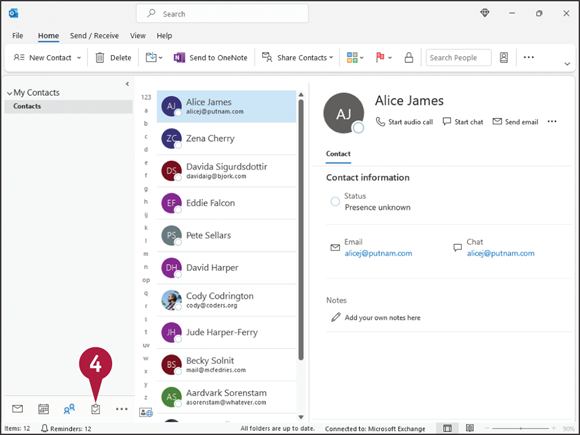
Outlook displays the People component.
![]() Click Tasks (
Click Tasks (![]() ) in the Navigation bar.
) in the Navigation bar.
Note: As you hover the mouse (![]() ) over Tasks (
) over Tasks (![]() ), Outlook displays a preview of upcoming tasks.
), Outlook displays a preview of upcoming tasks.
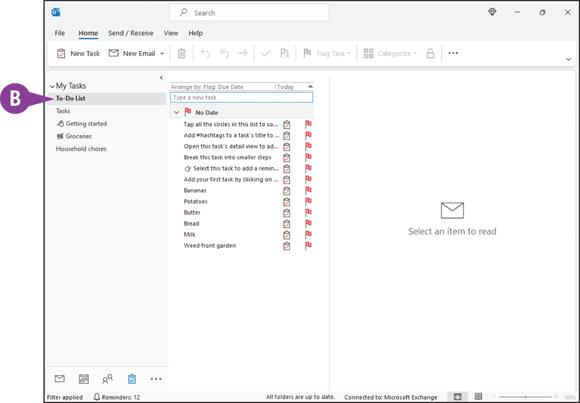
![]() Outlook displays the To-Do List of the Tasks component.
Outlook displays the To-Do List of the Tasks component.
Schedule an Appointment
You can use Outlook’s Calendar component to keep track of your schedule. When adding new appointments to the Calendar, you fill out appointment details, such as the name of the person with whom you are meeting, the location and date, and the start and end times. You can also enter notes about the appointment, as well as set up Outlook to remind you of the appointment in advance.
If your appointment occurs regularly, such as a weekly department meeting, you can set it as a recurring appointment. Outlook adds recurring appointments to each day, week, or month as you require.
Schedule an Appointment

![]() Click Calendar (
Click Calendar (![]() ) in the Navigation bar.
) in the Navigation bar.
![]() Click the date for which you want to set an appointment.
Click the date for which you want to set an appointment.
![]() You can click these arrows (
You can click these arrows (![]() and
and ![]() ) to navigate to a different month.
) to navigate to a different month.
![]() You can click these buttons to select a different calendar view, such as a daily or weekly view.
You can click these buttons to select a different calendar view, such as a daily or weekly view.
![]() Click New Appointment to display the Appointment window.
Click New Appointment to display the Appointment window.

![]() Type a name for the appointment.
Type a name for the appointment.
![]() You can type the appointment location here.
You can type the appointment location here.
![]() Click the Start time
Click the Start time ![]() and set a start time.
and set a start time.
![]() Click the End time
Click the End time ![]() and set the end time.
and set the end time.
![]() You can type notes about the appointment here.
You can type notes about the appointment here.
![]() Outlook automatically sets a reminder that you can change by clicking the Reminder
Outlook automatically sets a reminder that you can change by clicking the Reminder ![]() .
.
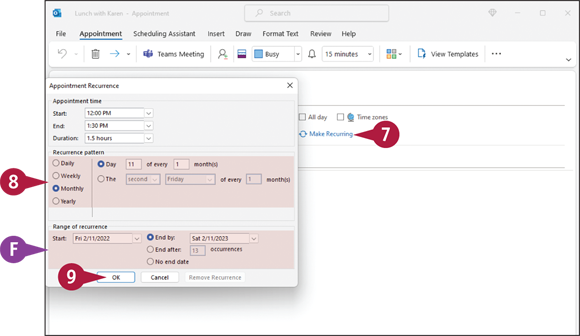
![]() If your appointment occurs regularly, click Make Recurring. Otherwise, skip to step 10.
If your appointment occurs regularly, click Make Recurring. Otherwise, skip to step 10.
The Appointment Recurrence dialog box appears.
![]() Select the recurrence pattern.
Select the recurrence pattern.
![]() In the Range of Recurrence section, you can limit the appointments if they continue only for a specified time.
In the Range of Recurrence section, you can limit the appointments if they continue only for a specified time.
![]() Click OK.
Click OK.
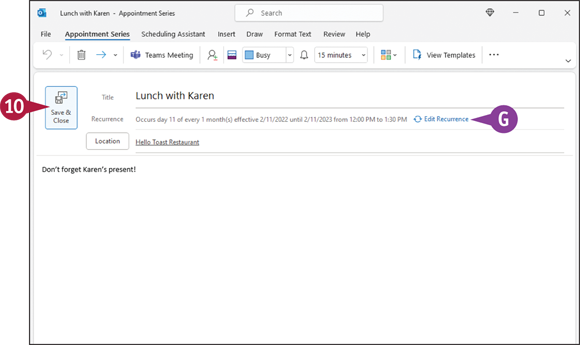
![]() Outlook marks the appointment as a recurring appointment.
Outlook marks the appointment as a recurring appointment.
![]() Click Save & Close.
Click Save & Close.
Outlook displays the appointment in the Calendar. To view the appointment details or make changes, double-click the appointment. To delete an appointment, right-click it and click Delete.
Note: If other people have access to your calendar, you can mark a personal event as private by right-clicking the event and then clicking Private.
Create a New Contact
You can use Outlook’s People component to maintain a list of contact information. You can track information such as your contacts’ home and business addresses; e-mail addresses; instant message addresses; company information; home, work, fax, and mobile phone numbers; and social media updates. You can also enter notes about a contact.
By default, Outlook displays contact information using the People view; you can edit contact information and interact with your contacts from the People view. You can also switch to other views such as the Business Card or List view.
Create a New Contact
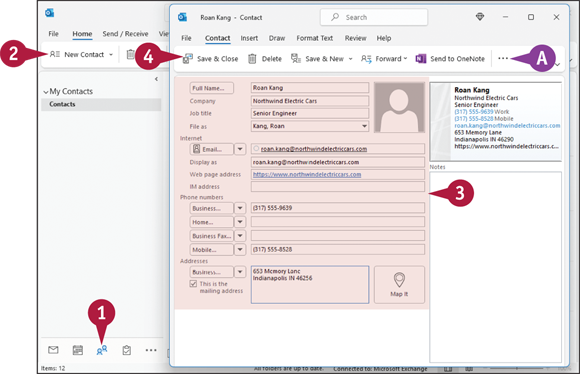
Create a Contact
![]() Click People (
Click People (![]() ) in the Navigation bar.
) in the Navigation bar.
![]() Click New Contact.
Click New Contact.
Outlook opens a Contact window.
![]() Fill in the contact’s information.
Fill in the contact’s information.
You can press ![]() to move from field to field.
to move from field to field.
![]() You can click More commands (
You can click More commands (![]() ) and then click Details to fill in additional information about the contact.
) and then click Details to fill in additional information about the contact.
![]() Click Save & Close.
Click Save & Close.
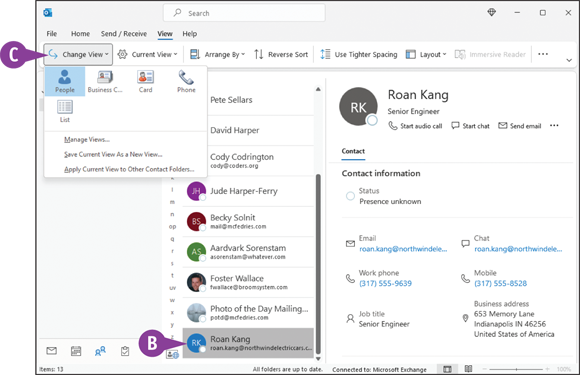
![]() Outlook saves the information and displays the contact in the People component.
Outlook saves the information and displays the contact in the People component.
![]() On the View tab, you can click Change View to see and switch to the available views.
On the View tab, you can click Change View to see and switch to the available views.
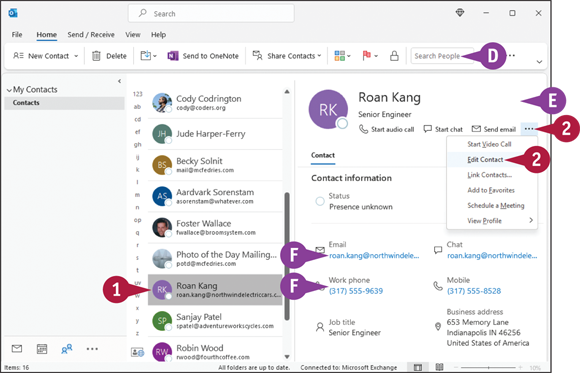
Work with the People Card
![]() Click a contact.
Click a contact.
![]() To find the contact, you can click here and type part of the contact’s name.
To find the contact, you can click here and type part of the contact’s name.
![]() Information about the contact appears here.
Information about the contact appears here.
![]() You can click these links to call the contact or send an e-mail to the contact.
You can click these links to call the contact or send an e-mail to the contact.
![]() To edit using the People card, click More commands (
To edit using the People card, click More commands (![]() ) and then click Edit Contact.
) and then click Edit Contact.

Outlook displays People card fields in an editable format.
![]() Make any changes.
Make any changes.
![]() Click Save & Close.
Click Save & Close.
Create a New Task
You can use Outlook’s Tasks component to keep track of things that you need to do; for example, you can create tasks for a daily list of activities or project steps that you need to complete. You can assign a due date to each task, prioritize and categorize tasks, and set a reminder date and time. You can set up a recurring task and even assign tasks to other people.
When you finish a task, you can mark it as complete. Depending on the current view, completed tasks may appear with a strikethrough on the Tasks list or they may not appear at all.
Create a New Task

![]() Click Tasks (
Click Tasks (![]() ) in the Navigation bar to open the Tasks component.
) in the Navigation bar to open the Tasks component.
![]() Click New Task.
Click New Task.
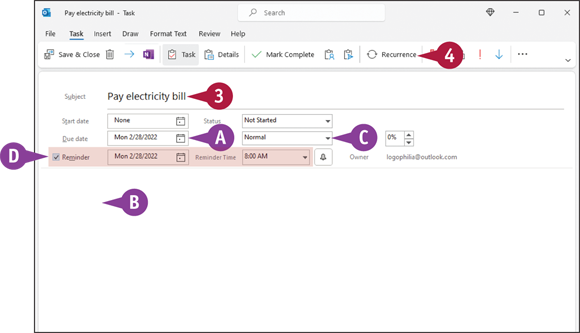
Outlook displays a Task window.
![]() Type a subject for the task.
Type a subject for the task.
![]() You can click the calendar icon (
You can click the calendar icon (![]() ) to enter a due date.
) to enter a due date.
![]() You can type notes or details about the task here.
You can type notes or details about the task here.
![]() You can set a priority for the task using the Priority
You can set a priority for the task using the Priority ![]() .
.
![]() You can select Reminder (
You can select Reminder (![]() changes to
changes to ![]() ) and then set a reminder date and time.
) and then set a reminder date and time.
![]() If your task occurs regularly, click Recurrence; otherwise, skip to step 7.
If your task occurs regularly, click Recurrence; otherwise, skip to step 7.
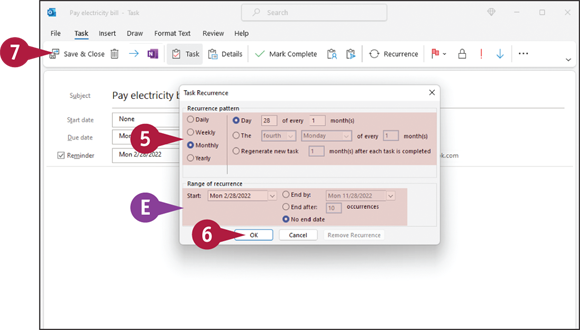
The Task Recurrence dialog box appears.
![]() Select the recurrence pattern.
Select the recurrence pattern.
![]() In the Range of Recurrence section, you can limit the tasks if they continue only for a specified time.
In the Range of Recurrence section, you can limit the tasks if they continue only for a specified time.
![]() Click OK.
Click OK.
![]() Click Save & Close.
Click Save & Close.
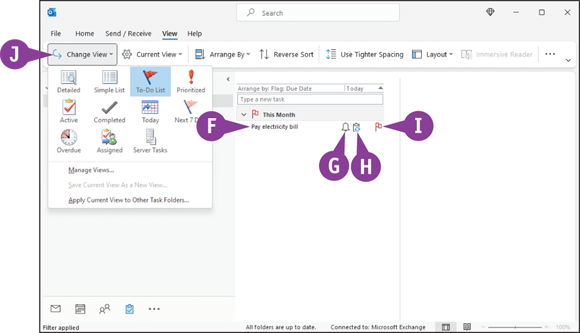
![]() Outlook displays the task in the list. Details of the selected task appear in the pane to the right of the list of tasks.
Outlook displays the task in the list. Details of the selected task appear in the pane to the right of the list of tasks.
Note: To edit a task, you can double-click the task to reopen the Task window.
![]() This indicator (
This indicator (![]() ) represents a reminder.
) represents a reminder.
![]() This indicator (
This indicator (![]() ) represents a recurring task.
) represents a recurring task.
![]() You can click a task and mark it complete by clicking Mark Complete (
You can click a task and mark it complete by clicking Mark Complete (![]() ).
).
![]() On the View tab, you can click Change View and choose a different view of tasks.
On the View tab, you can click Change View and choose a different view of tasks.
Add a Note
Outlook includes a Notes component, which you can use to create notes for yourself. Much like an electronic version of yellow sticky notes, Outlook’s Notes component enables you to quickly and easily jot down your ideas and thoughts. You can attach Outlook Notes to other items in Outlook, as well as drag them from the Outlook window onto the Windows desktop for easy viewing.
Add a Note

![]() Click More (
Click More (![]() ) to display a pop-up menu.
) to display a pop-up menu.
![]() Click Notes to open the Notes component.
Click Notes to open the Notes component.
![]() Click New Note.
Click New Note.
![]() Outlook displays a yellow note.
Outlook displays a yellow note.
![]() Type your note text.
Type your note text.
![]() When you finish, click the note’s Close button (
When you finish, click the note’s Close button (![]() ).
).
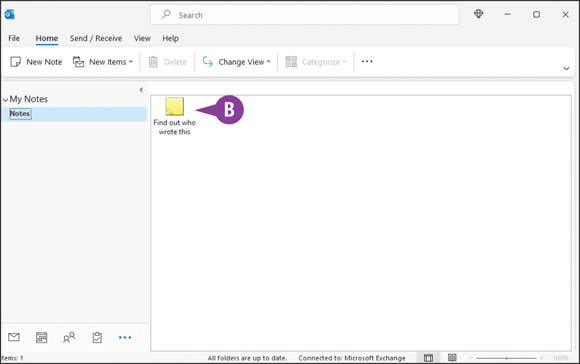
![]() Outlook adds the note.
Outlook adds the note.
To view the note again or to make changes, you can double-click it.

![]() To change your view of notes, you can click Change View.
To change your view of notes, you can click Change View.
This example displays the Notes List view.
Customize the Navigation Bar
You can control the appearance of the Navigation bar, displaying fewer items or more items to suit your needs. For example, suppose that you use the Notes component regularly. You can save mouse clicks if you display the Notes component as part of the Navigation bar.
In addition to determining which components appear on the Navigation bar, you can control the order in which they appear. You can also control the size of the Navigation bar by choosing to display buttons that represent each component instead of displaying the component name.
Customize the Navigation Bar
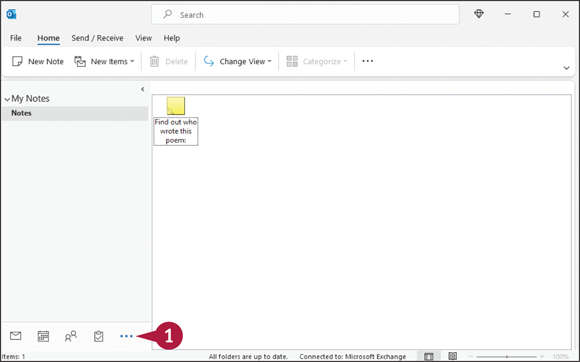
![]() From any Outlook component, click More (
From any Outlook component, click More (![]() ).
).
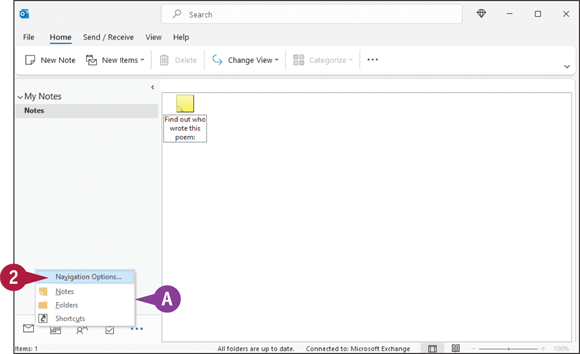
![]() A pop-up menu appears.
A pop-up menu appears.
![]() Click Navigation Options.
Click Navigation Options.
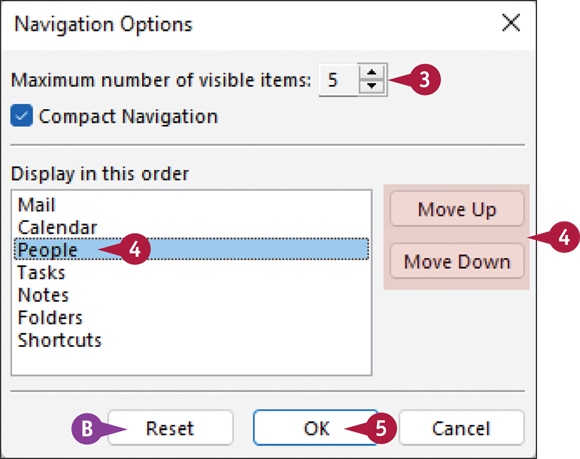
The Navigation Options dialog box appears.
![]() Click
Click ![]() to specify the number of items you want visible on the Navigation bar.
to specify the number of items you want visible on the Navigation bar.
![]() To reorder the Navigation bar entries, click an item and then click Move Up or Move Down.
To reorder the Navigation bar entries, click an item and then click Move Up or Move Down.
![]() You can click Reset if you want to return the Navigation bar to its original state.
You can click Reset if you want to return the Navigation bar to its original state.
![]() Click OK.
Click OK.
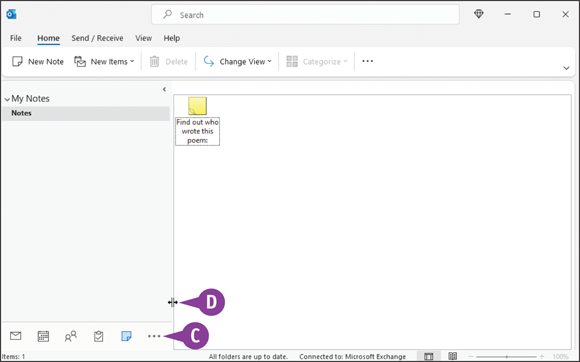
![]() The Navigation bar appears with your changes.
The Navigation bar appears with your changes.
![]() You might need to widen the left pane in Outlook to see all the Navigation buttons. Slide the mouse over the pane divider (
You might need to widen the left pane in Outlook to see all the Navigation buttons. Slide the mouse over the pane divider (![]() changes to
changes to ![]() ) and drag the pane divider to the right.
) and drag the pane divider to the right.
Peek at Appointments and Tasks
From any Outlook component, you can take a peek at today’s appointments and at your task list. You do not need to select the Calendar component or the Tasks component to view appointments or tasks.
If you also unpin the Folder pane, which is pinned by default, you hide the leftmost pane in each component view and give more real estate to each component. When you hide the Folder pane, you can peek at appointments and tasks, and you also can pin the peeked view so that it remains visible for as long as you need to see it.
Peek at Appointments and Tasks
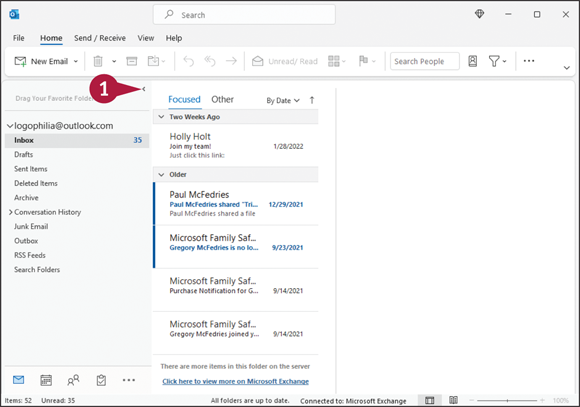
![]() To hide the Folder pane, click the Minimize the Folder Pane button (
To hide the Folder pane, click the Minimize the Folder Pane button (![]() ).
).
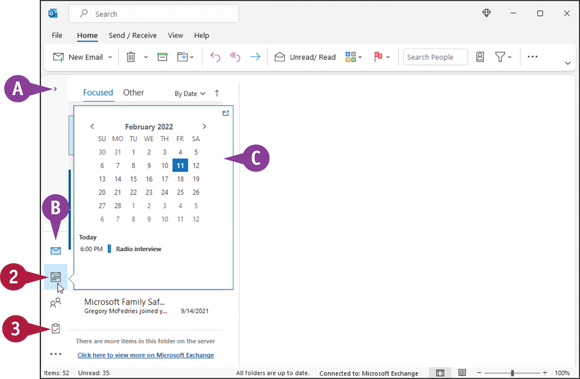
![]() Outlook hides the Folder pane and instead displays the Expand Folder Pane button (
Outlook hides the Folder pane and instead displays the Expand Folder Pane button (![]() ).
).
![]() Outlook docks the Navigation bar buttons on the left side of the screen.
Outlook docks the Navigation bar buttons on the left side of the screen.
![]() To peek at your appointments, hover the mouse (
To peek at your appointments, hover the mouse (![]() ) over Calendar (
) over Calendar (![]() ) on the Navigation bar.
) on the Navigation bar.
![]() Outlook displays a small window that enables you to “peek” at your calendar.
Outlook displays a small window that enables you to “peek” at your calendar.
![]() To peek at your tasks, hover the mouse (
To peek at your tasks, hover the mouse (![]() ) over Tasks (
) over Tasks (![]() ).
).
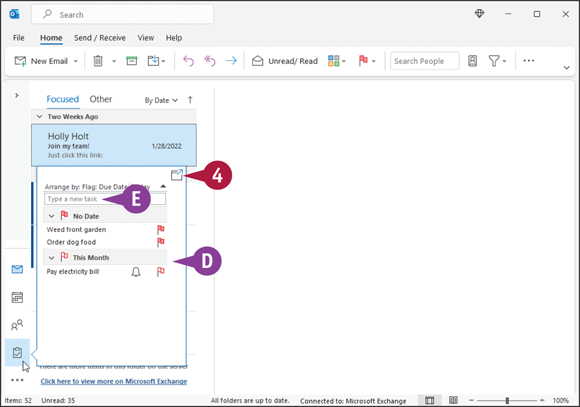
![]() Outlook displays a list of your tasks.
Outlook displays a list of your tasks.
![]() You can click here and type a name to add a new task.
You can click here and type a name to add a new task.
Note: When you press ![]() to add the task, Outlook adds the task to your list as a task for today. See the section “Create a New Task,” earlier in this chapter, for details on editing the task.
to add the task, Outlook adds the task to your list as a task for today. See the section “Create a New Task,” earlier in this chapter, for details on editing the task.
![]() To pin a peek view so that it is permanently visible, click the Dock the Peek button (
To pin a peek view so that it is permanently visible, click the Dock the Peek button (![]() ).
).
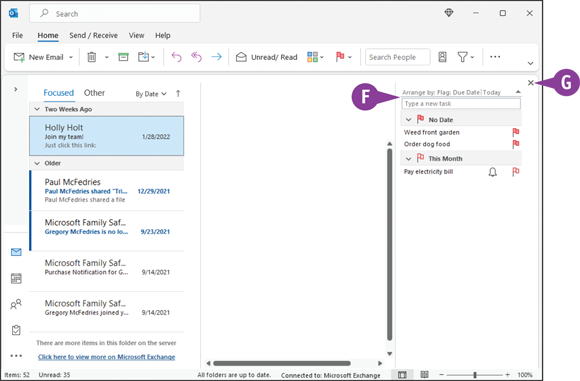
![]() Outlook pins the tasks or appointments to the right side of the current component’s window.
Outlook pins the tasks or appointments to the right side of the current component’s window.
Note: The pinned peek view appears only in the component you were viewing when you pinned it.
![]() You can click the Close button (
You can click the Close button (![]() ) to unpin the peek view.
) to unpin the peek view.
